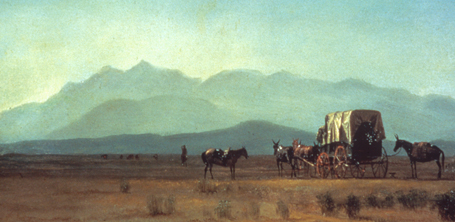- Teacher Resources
- Books & Authors


Pioneer life has a special meaning in America. In less than 300 years, settlers spread across a vast wilderness that covered the western United States. From the first landings in Virginia and Massachusetts in the early 1600s, American settlers kept pushing westward against an ever moving frontier. Into wild country went hunters, trappers, fur traders, miners, soldiers, surveyors, and farmers. Every part of America had its pioneers.
In the 1840s and 1850s the western frontier began at the Mississippi River. Hundreds of thousands of pioneers made the long trek west to new frontiers in Oregon and California. For months they lived in covered wagons stuffed with all their possessions. These adventurers traveled in caravans, with 30 or more wagons rocking westward on the overland trails. On fine days a wagon train could cover 20 miles (32 kilometers); when the rains brought mud, the pioneers would be satisfied to cover half that distance. To learn more about the journey west, read Joshua's Oregon Trail diary.
Once pioneers arrived at their destination, their journey had only just begun. With few resources, settlers had to rely on themselves and the land. Hunting wild animals provided some food and leather for clothing. New settlers also gathered wild fruits, nuts, and berries until they could plant their own crops. Pioneer women learned to supply their own household goods. Gourds served as pails and dippers. Wood ash was made into soap. Tallow, sheep and cattle fat was molded into candles. Every cabin had two spinning wheels — a big wheel for wool and a smaller wheel for flax, the fiber from which linen was made.
Pioneer families tended to be large. Most cabins had a cradle, hollowed from a log, and the cradle was rarely empty. Children were helpful in new lands. Girls soon learned important household tasks — gardening, cooking, spinning, weaving, mending, sewing, making soap and candles. Boys worked in the woods and fields with their fathers. They learned to chop wood, to clear out brush, to split rails, and to build fences. Pioneer children were also in charge of keeping animals away from the fields. A rail fence would keep hogs and sheep out of the corn, but deer could leap that barrier. It was the children's job to chase the deer away and to keep squirrels from devouring the growing crop. Sometimes children also pounded dried corn to make cornmeal.
Of course, pioneers had more to worry about than just everyday household duties. The arrival of so many Americans on the western frontier sparked a war with Mexico over land. Americans who had settled in Texas had revolted against Mexico, formed an independent republic, and asked that Texas become part of the United States. America went to war with Mexico in order to incorporate Texas into the Union.
Many Americans also wanted to obtain more than just Texas. They sought to acquire, by purchase or conquest, other Mexican territories, including California. They believed that it was the destiny of the United States to span the continent from the Atlantic to the Pacific and from the Canadian border south to the Rio Grande, the river that is now the boundary between the United States and Mexico.
As pioneers demanded more land, problems with Native American tribes also increased. Between 1850 and 1880, numerous treaties were negotiated between whites and Indians in all parts of the West, from Nebraska to California. The original reason for these treaties was to separate the two groups and reduce the risk of war. But as the size of the settler population increased, the agreements gained a new purpose: to get good land for white settlers.
Indian tribes were restricted to reservations where their lives were controlled by unsympathetic government agents and many of their cultural traditions were forbidden. Many tribes resisted and fought back against the American government and settlers, but all of the tribes were defeated. In the 1860s and 1870s, this process of "clearing" the West for white settlement led to conflicts with the Navajos, Kiowas, Blackfeet, Comanches, Sioux, and Cheyennes.
Through their labors and accomplishments, pioneers helped define the character of America. Looking for opportunity and happiness, families risked their lives to build new communities far from the settled east coast. However, in the quest for a bigger America, Native American communities were destroyed and a war was fought with Mexico.
To learn more about the struggles and successes of pioneer life, read the journals of Augustus Pelletier, who explored with Lewis and Clark and Sarah Nita, a Navajo girl, as well as Susanna Fairchild, who participated in the Gold Rush.
